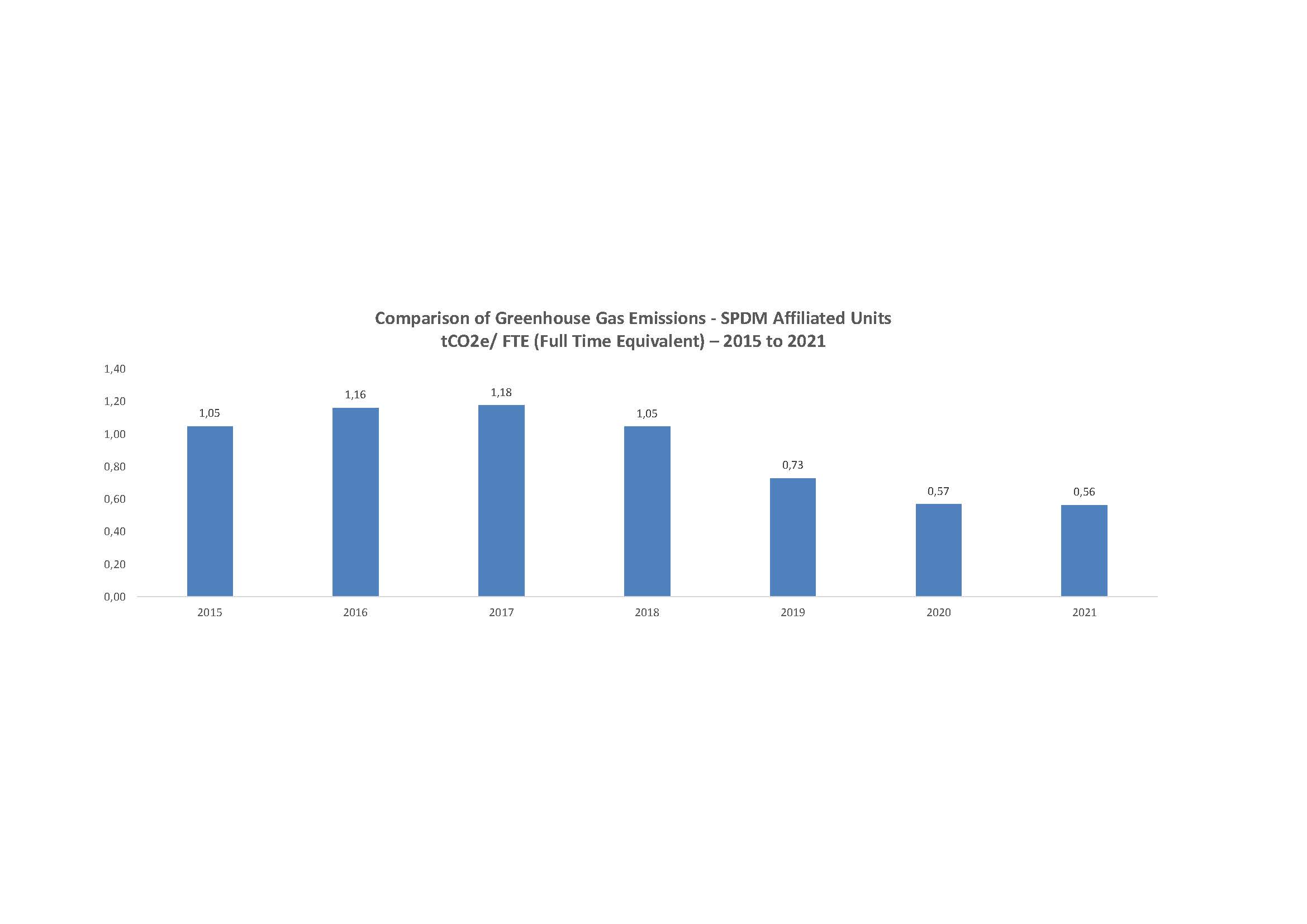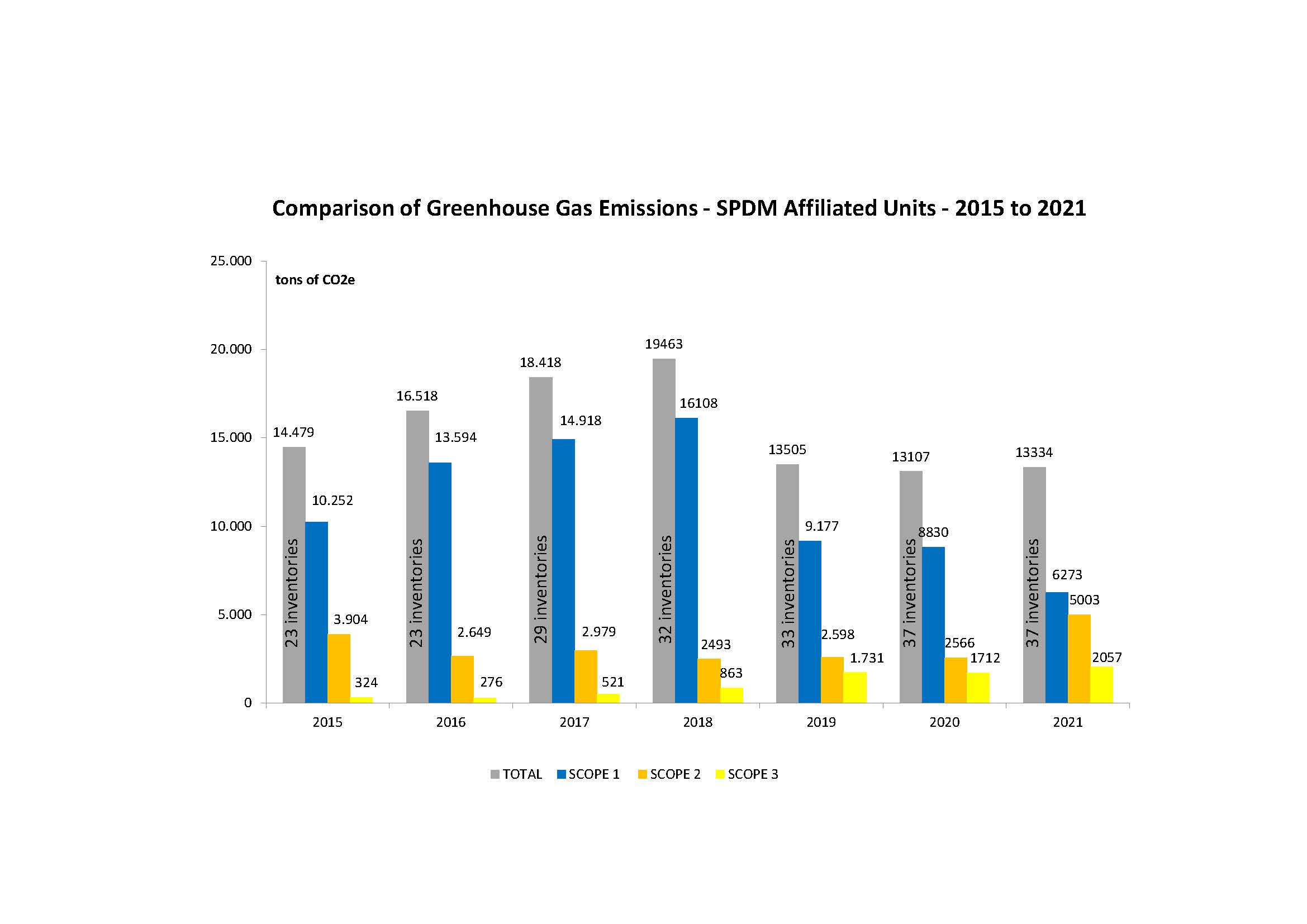Health system nearly halves GHG emissions making great strides in their Race to Zero
Associação Paulista para o Desenvolvimento da Medicina (SPDM), Brazil
Case study summary
Starting in 2015 the Associação Paulista para o Desenvolvimento da Medicina (SPDM) conducted extensive greenhouse gas inventories and implemented sustainable strategies throughout its facilities. They achieved a significant reduction in emissions (nearly a 50% reduction in emissions in tCO₂e per FTE from 2018 to 2022), expenses (savings of USD 62,000 in 2020), and increased awareness and acceptance of health care sustainability and environmental impact among staff, health care leadership, the government, and the communities served.
Demographic information
- City: Sao Paulo
- State/province/region: SP
- Country: Brazil
- Type of institution: Health system (management of public health services)
- Number of full-time staff: 12,399
- Number of part-time staff: 19,139
- Number of beds: 4,349 (3,365 admissions + 802 ICU + 182 day care treatment)
- Patient population served annually:
- ~16,000,000 patients served (inpatient, outpatient care, exams, high-cost drug delivery program)
- 2,335,000 patients served annually (185,000 inpatient and 2,150,000 outpatient)
- Geographic area served: State of São Paulo (approximately 45 million inhabitants) and municipality of Uberlândia, Minas Gerais (approximately 700,000 inhabitants) - Brazil
- Top 1-3 health equity concerns experienced by your population: Most SPDM services are included in the Brazilian public health system, which has the following principles: universalization (guaranteed access to all people); equity (investing more where the need is greatest); and integrality (meeting the needs of all people). For this project, it is important to integrate actions, including health promotion, disease prevention, treatment, and rehabilitation. Among the actions, we highlight the hiring of local labor in health services located in peripheral regions, the efficient use of public resources to facilitate the care of more patients, and the implementation of quality management systems with processes that seek greater safety for population health.
The issue
In 2015, health sector greenhouse gas inventories were not a reality in Brazil, as the public emissions registry platform had data from only five health organizations. SPDM started its activities after considering the impact of climate change on the population's health, institutional values, low representation of the health sector addressing climate, the existence of a free Brazilian tool for inventories, and the launch of the Health Care Climate Challenge.
Hospital goals
The objective was to develop a climate leadership strategy including:
- Raising awareness among employees on the topic of climate change.
- Developing actions to reduce emissions and expenses, such as GHG emissions management.
- Establishing ambitious targets for reducing emissions, including joining the Race to Zero campaign.

SPDM, an institution with more than 90 years and fulfilling its mission of doing social well-being, has been bringing innovation in the healthcare services management model. This allows the Institution to broaden the horizon of public management. We understand that climate change has and will have an increasing impact on the population's health and, consequently, on the health System. The services must work to reduce their impacts on the climate and develop plans to face possible impacts caused by climate change. The work developed by SPDM so far has already shown environmental and financial gains.
Sustainability strategy implemented
In 2016, an event promoted by the SPDM superintendence in partnership with Healthy Hospitals Project addressed climate change, followed by dozens of meetings to raise employee awareness. Workshops were held to orient staff to the calculation tool. Having a strategic goal helped with the preparation of greenhouse gas inventories, which have become standard practice through the use of a management tool that has been guiding several initiatives to reduce emissions. SPDM was also a pioneer in the health care climate challenge and joined the Race to Zero campaign in 2021.
Implementation process
The team's process for raising awareness and developing a GHG inventories tool was coordinated by the institution's environmental engineer. It incorporated input from different sectors (engineering, building maintenance, clinical engineering, transport, hospitality, pharmacy) to guarantee the quality and timeliness of data. The establishment of a strategic goal, leadership support, centralization, and data-gathering process were fundamental for success. The first inventory from 2015 consolidated information from 23 health care services managed by SPDM, and the last version from 2021 contained 37 inventories. Over the years, the management of emissions has enabled institutional actions such as the significant reduction of emissions related to nitrous oxide, as well as the replacement of fluorescent lamps with LEDs. The actions developed by the local teams also had a significant impact on reducing emissions. The journey to reduce emissions is ongoing, and joining Race to Zero in 2021 marks a new phase in the process.
Tracking progress
Results are measured annually considering each individual care unit and on a consolidated basis. Individual assessment allows each service to evaluate its performance by scope and type of issue over time. The consolidated inventory illuminates major changes that need to be addressed to reduce emissions. In addition to inventory data, the institution established an indicator that evaluates emissions per full-time equivalent (FTE) employees. Adopting the year 2018 as a base, there was a 46,7% reduction in emissions in tCO₂e per FTE.

Progress achieved
Among the benefits achieved, the following stand out:
- Significant reduction of emissions (almost 50% reduction tCO₂/FTE between 2018 and 2021).
- Reduced costs with purchasing nitrous oxide (savings of USD 62,000 in 2020).
- Reduction of energy costs.
- Increased awareness among health professionals about climate change.
- Training professionals on the preparation of GHG inventories.
- Participation of a variety of health professionals (anesthesiologists, pharmacists, and others).
- Development of local initiatives, with some local projects receiving the Global Climate Challenge Awards and others the Environmental Friendship Award from the São Paulo State Department of Health (links below).
- Presentation of work at international events (Resiliente Cities 2017 in Bonn, and CleanMed 2018 inSan Diego).

Challenges and lessons learned
The development of a strategy covering several aspects of the project is important to success, such as raising awareness of the institution's health services, training professionals, preparing and forwarding reference materials, and checking and validating data. A persistent challenge is dealing with limited financial resources to advance the project.
Next steps
Based on work done to date and the results of the last inventories, the institution has verified that Scope 2 emissions (electricity) need to be addressed. There is interest in developing, on a corporate basis, actions related to the acquisition of electricity from renewable sources. The institution has already been implementing energy management systems (ISO 50001) aimed at better energy performance.
Links
- Associação Paulista para o Desenvolvimento da Medicina, Brazil: GOLD- Climate Leadership
- SPDM- Hospital Geral de Pedreira, Brasil: GOLD- Greenhouse Gas Reduction (Non-energy)
- SPDM – Associação Paulista para o Desenvolvimento da Medicina – São Paulo (Brazil) Gold – GHG Reduction (Energy)
- SPDM – Associação Paulista para o Desenvolvimento da Medicina (Brazil) - Gold – Greenhouse Gas Reduction (Non-energy)
- SPDM – Associação Paulista para o Desenvolvimento da Medicina (Brazil) - Greenhouse Gas Reduction (Energy) – Gold / Hospital Geral de Guarulhos Prof. Dr. Waldemar Carvalho Pinto Filho (Brazil) Greenhouse Gas Emissions Reduction (Non-energy) – Silver
- Hospital de Transplantes Euryclides de Jesus Zerbini (Brazil) – Energy Efficiency - Silver
- Environmental Friendship Award 2018– Hospital de Transplantes Euryclides de Jesus Zerbini
- Environmental Friendship Award 2018 – Hospital Geral de Pedreira
- Environmental Friendship Award 2019– Hospital de Transplantes Euryclides de Jesus Zerbini
- Environmental Friendship Award 2020– Hospital Geral de Pirajussara
- Evento discute o papel das organizações de saúde no tema “mudança do clima”
- SPDM é premiada no “Desafio 2020 – A Saúde pelo Clima”
- Instituições Afiliadas assinam compromisso com a campanha mundial “Race to Zero”
- Hospitais Saudáveis Race to Zero